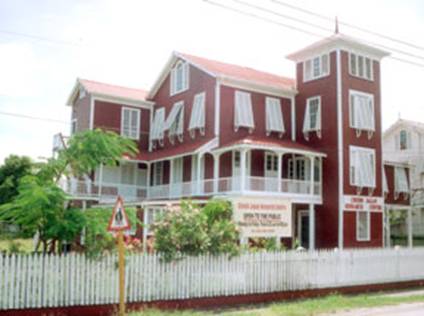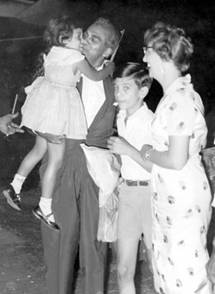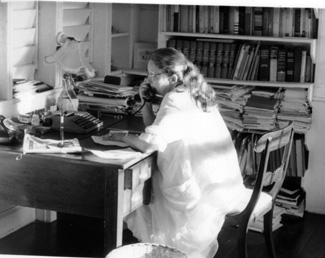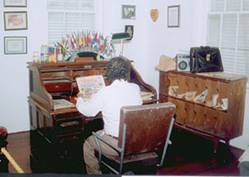About the Cheddi Jagan Research Centre
About Red House
The changing fortunes of ‘Red House’
-- From elitist living quarters, to near ruins, to cultural mecca
By Linda Rutherford

She ranks among some of our oldest and most historic buildings, is rated a national monument by the National Trust of Guyana, and, if all goes well, is soon to become a World Heritage Site as part of Historic Georgetown.
She is the famous ‘Red House’, custodian of some of the most intimate and treasured of secrets of some of the most distinguished and influential of men and women to have traversed this land - from colonial secretaries, said to be equal in stature to the governor and responsible for the day to day running of the government back in the old colonial days; to former Speaker of the House, the late Sir Eustace Woolford; and most renowned of all its occupants, the late Dr Cheddi Jagan, whom it is alleged deliberately chose to live there because its colour was reflective of his Communist ideals.
Not so, says his widow and former President, Mrs Janet Jagan.
“I don’t think there was anything else available at the time… I think it was felt that since he was Premier, we shouldn’t continue to live where we were in Queenstown. We had a rented house there,” she told the Sunday Chronicle.
The property at reference is an elegant distinctive red three-storey edifice on upper High Street in up-market, ‘old-money’ Kingston, just across the way from Austin House, another national relic and home to the head of the Anglican Diocese here, Bishop Randolph George and his family.
Dr Jagan, co-founder and leader of the governing People’s Progressive Party (PPP), and his family lived there from 1961 to 1964 during his tenure as elected Premier, the first ever in the annals of then British Guiana.

At the time, Mrs Jagan recalls, Joey, the older of their two children, must have been around 13 or 14, as he’d already started high school. He attended Queen’s College, then one of the country’s premier secondary schools for boys. Their daughter, Nadira, she said, “must have been about six or so.”
Asked what it was like living there as a young mother and housewife, Mrs Jagan, a veteran politician as well as a seasoned journalist, countered that she didn’t think the latter term rightly applied to her since most of her time was spent at ‘Freedom House’, as the party headquarters is called.
“During this period, I wasn’t really a housewife, you see…I was at ‘Freedom House’ every day. And then, during one period for a year I was a minister. So I wasn’t exactly a housewife.”
Responding to the question nevertheless, she said: “Of course, it was huge. It had three floors. We slept on the top floor… and the middle floor we ate…and there was a reception room too. The bottom floor was used partly by guards and partly as a playroom for my son.”
She fondly remembers the grand old time he had down there playing with the train set he’d gotten as a present one Christmas.
Luckily for her, she said, she had in her employ two of the best domestic helps one could ever hope to find, one of whom was a Surinamese woman who had previously worked for a doctor she knew.
“She was a very good cook. She just came to Red House and asked for a job…and the minute I found out who she was, I employed her…she was fantastic…, Mrs Jagan said, adding: “She’s probably one of the best chefs this country’s ever had, and I was just lucky to have her.”
When they had guests over, she said, it was this woman who oversaw everything. “She took over and she was very capable.” She lived in the little matching red cottage aback the premises -- the servants quarters they were called in those days. Between she and the other woman, a local who had been with the family for a number of years, they took care of the day to day running of the house. “So that part of the running of the place was quite comfortable,” the former First Lady said.
Looking back on the four years she and her family spent at the ‘Red House’, she said: “I think my children enjoyed it because it had a big yard. We also had a dog and a monkey.”
The thing she liked most about living there, she said, was the quietude. “It was very pleasant…but plain. Plain -- because we didn’t have an awful lot of furniture. What I liked, however, was the beauty of the place …the simplicity of it…it’s a beautiful building. It’s a nice area…a beautiful part of Guyana, Kingston …”

There were also certain other features about the house that she found quite intriguing - like the secret stairway that led to a bedroom she and her husband shared to the floor below.
The tower, which was a favourite haunt of hers and is still intact after all these years, was another place she found to be equally as interesting as the hidden stairwell in her bedroom.
“The tower had steps going up. I put a table up there, because I used to love to go up there and write or read…it had a beautiful view…but this one …the bedroom…I don’t think it exists any more…but it had steps going down to what was a little office. But the bedroom was massive…but that’s how things were in the old days. That little tower is still there also.”
In all, there were four bedrooms, she said. “One we kept for guests…my son had one…my daughter had one…and my husband and I had one.”
Since the restoration of the house, however, courtesy of the multinational logging firm, Barama Company Limited, those rooms have now been converted into a museum, one of three components of the Cheddi Jagan Research Centre, which is being housed there.

holds a pencil portrait of
Red House done by an Indian artist.
In those rooms, Mrs Jagan said, is where all the gifts her husband received during his tenure as President (1992–1997) are displayed. The area also serves as a repository for a number of photographs and paintings, going all the way back to 1940s, among a host of other memorabilia belonging to Dr Jagan, right down to a scaled-down version of the office from which he worked while he lived at State House.
According to Mrs Jagan, the audio/visual recordings of his select speeches and various aspects of his life are particularly popular with the public, especially the younger generation, as they go there regularly, either as a group or individually, to make use of this facility.

in its original form at Red House
Meanwhile, the middle floor is where all the archiving and documentation takes place, while the ground floor has been reserved for hosting conferences, workshops, training programmes, and the occasional book launch among other related activities.
It’s capacious and well-appointed lawns, however, have been used from time to time to host such social events as wedding receptions, fashion shows, and just recently a novelty pet show and fair, courtesy of the Tourism and Hospitality Association of Guyana (THAG).
“So, it’s a very busy place…people are in and out,” Mrs Jagan said, in obvious reference to the goings on these days at ‘Red House’.
According to Dr James Rose, who is not only a part of the management committee but a historian by profession, while much of its architectural history is shrouded in obscurity, there is every indication that ‘Red House’ was built somewhere in the latter half of the 19th century, many of its features are obviously 20th century.
And while he does not elaborate on this latter comment of his, he does concur that its name was derived from the colour of the shingles used in its construction, which is of red wallaba, a type of hardwood native to Guyana.
Both the use of shingles and the incorporation of a tower into the building’s architecture, it is said, are a dead giveaway that it had to have been constructed during the late 19th century since either feature was quite fashionable at the time. It is also said that many ‘tower’ homes, as they are called, belonged to people with shipping connections or those merchants who wanted advance warning of when their vessels were due.
Though Sir Eustace, who was Speaker from 1953 to 1957, fell into neither category, he was reportedly one of the previous owners of ‘Red House’, which had to have been before 1925, when, according to the National Trust, it became the official residence of whoever the Colonial Secretary happened to be at the time, right up until 1953.
Dr Rose, however, seems to think that at some point during the 1940s, the building was acquired by the Colonial Development and Welfare Division since while it could not be confirmed that the first ever appointed Colonial Economic Development Officer, one Mr. Spencer, lived there, he was “reasonably certain” that his successor, a Mr. Fletcher, did.
Following the departure of Dr Jagan and his family in the wake of the 1964 polls, Dr Rose said, ‘Red House’ “fell upon increasingly hard times,” largely because of a reluctance on the part of his successor, the late Forbes Burnham, to take up residence there.
As such, he said, the property, which by this time was acquired by the State, was used to house firstly the Department of External Affairs, and subsequently the Training Division of the Public Service Ministry. It was, for reasons unknown, abandoned in the early 90s.
The legend of Dr. Cheddi Jagan lives on at `Red House’
A GIS Feature by Sheleeza Baksh
IN RECENT years, there has been significant growth and interest in historical artifacts, research and documentation of distinguished Guyanese personalities, which are on display in museums and other institutions.
With the quest to establish comprehensive bibliographic data and re-live the spirit of the legendary former President Dr. Cheddi B. Jagan, the refurbished 'Red House' on High Street was officially designated the Cheddi Jagan Research Centre (CJRC) on March 22, 2000. This date also commemorated Dr. Jagan’s 82nd birth anniversary.
The location is temporary and sometime in the future, a more befitting edifice may be built. However, the downtown area has been significantly transformed with the graceful contrasting architecture of the Umana Yana, Le Meridian Pegasus and the Red House.
The 19th century three-storey Greenheart structure, with its British colonial architecture, Dutch heritage and a tower overlooking the Atlantic Ocean and part of the city of Georgetown, is famous for its wooden ‘Demerara Shutters’ (windows).
Research shows it was referred to as the historic 'Red House' because of the colour of the protective coating of shingles. According to historian Dr. James Rose during his address at the launching of the Cheddi Jagan Research ‘Institute’ on March 5 1998, for many persons particularly in the 1960's, 'Red House' represented “the house in which the communist Jagan lives.” He explained that red in this sense owed its derivation not to the colouration of the building, but rather to the political ideology of the person who resided therein.
Over the long years of his political career, Dr. Jagan wrote several books, presented many papers and delivered numerous speeches. Many of them are available in print, audio and video formats at this institution which has already become famous.
According to Archivist/Librarian, Mr. Dudley Kissoore, the centre was established in honour of Dr. Jagan to collect “the works of this eminent third world statesman, the story of his life, his early political administrative career, his struggles, achievements and capturing for history his influence on local, regional and international affairs during the 1940’s to the 1990’s.”
He added that CJRC is dedicated to making available to both local and international researchers, the legacy and work of Dr. Jagan through research and education, easily affordable and accessible in one convenient location. In earlier days, some of the more powerful and illustrious colonial personages occupied the `Red House’. For some time, it served as the official residence of the British Colonial Secretaries who would have also acted as colonial Governors for varying lengths of time. In the 1940’s, the building was passed on to the Colonial Development and Welfare Division.
Mr. Eustace Woolford, a renowned colonial political maverick and one-time Speaker of the Legislative Assembly, occupied the house in the pre-1950’s. It was subsequently secured by the Government and served as residence of the first Premier of British Guiana, Dr. Jagan, between 1961 and 1964. It was subsequently used by the Department of External Affairs and as Training Division of the Public Service in the 1980’s when it fell into disrepair.
Mr. Kissoore told the Guyana Information Services (GIS) in an exclusive interview that rehabilitation work began since 1996 through a grant provided by Barama Company Ltd.
He stressed that the architectural work of the heritage building, done by Mr. Carlton Ambrose, Francois and Associates, should be kept for posterity.
The Archivist explained that CJRC has three important working components: a museum, an archive and a conference centre. The museum on the top floor has on display a collection of photographs and paintings from the 1940’s arranged to portray the philosophy, aspirations, preoccupations, the struggle and the accomplishments of Dr. Jagan and his involvement in the national and international political arena.
It also has facilities where individuals can select one of Dr. Jagan’s speeches or significant episodes from his life from audio/visual materials. Employing modern advancements in electronics and design to produce an interactive relationship between the researcher/viewer and the exhibits, to impart a multi-dimensional impact.
The museum also has on exhibition some of the pieces of gift items he received as President locally and overseas. A replica of Dr. Jagan’s study when he worked at home (State House) as President of Guyana, has been recreated at the Centre.
The ultimate goal of the museum is to make the experience of contemporary history as direct and intense as possible for visitors. Mr. Kissoore added that it must at all times represent a dynamic exhibition of items drawn from the Jagan legacy.
The archive on the middle floor houses a large collection of important documents such as the personal papers of Dr. Jagan, copies of the public records for understanding the issues and actions of his Administration, transcripts, interviews, collection of books, magazines, newspapers, pamphlets and printed documents bearing upon Dr. Jagan.
According to the Librarian, about 600 pieces have already been listed and there are another 600 papers dealing with various issues. Stating that the preparation of an information storage and retrieval system for the Archival Collection is now in progress, Mr. Kissoore explained that he is in the process of creating a database/index of all the documents using a UNESCO bibliographic programme.
Some of Dr. Jagan’s works found at the centre include Selected Speeches from 1992 to 1994, Forbidden Freedom, My Fight for Guyana's Freedom, West on Trial, A New Global Human Order, Bitter Sugar, Poverty: Cause and cure in Developing Countries, British Guiana’s Future – Peaceful or violent?
It is hoped that the archive would become a centre for the study of contemporary Guyana, its economic development goals, ethnic and political conflict and reconciliation, and national and foreign policy.
Mr. Kissoore revealed that Dr. Jagan’s original writings are being scanned, printed, and masked on CD-ROM. He noted that writings for the period from 1942 to 1964 are almost completed and are now available for use by students from the University of Guyana, High Schools, Critchlow Labour College and other academic institutions to carry out research. Local and overseas students (up to the Doctoral level) are eager to access the collection for study and research on 20th Guyanese and Caribbean history.
The Conference Centre or training room at the ground level seeks to project some of Dr. Jagan’s deepest concerns, his attempts to reconcile the world of ideas, action, scholarship and political decision-making, as they co-existed throughout his lifetime. Mr. Kissoore said it is also used by Government, local and international organisations to conduct training and they have expressed immense satisfaction regarding the facilities.
Mr. Ron Van Oers of UNESCO World Heritage Centre, during a recent visit, was impressed with the “outstanding example” of the physical outlook of the Red House and the use to which it has been put. He told Mr. Kissoore there is a possibility that it could be put on the list of World Heritage buildings. He was also impressed with the spacious lawns, which, according to the Librarian, are suitable for open-air activities such as receptions of various nature and social activities including fund-raising ventures.
The CJRC is a non-profit Non Governmental Organisation (NGO), which provides access to the entire archival collection, free of charge. It is supported by charitable donations and fund raising ventures both locally and overseas, and by rental of the lecture hall.
Mr. Kissoore said that the centre is managed by a Board of Trustees headed by Mrs. Janet Jagan and Management Board who together decided on the temporary location for the centre and is responsible for all fund raising ventures. At present the centre has a staff of three including a librarian, an assistant and a person who does cleaning and photocopying.
Mr. Kissoore stated that the aims and objectives of the research centre are to publish material and promote research on the life, work and ideas of Dr. Jagan and to promote research into the history of Guyana as a whole from the early 1940’s to the late 1990’s. On average, approximately 150 persons visit the Red House monthly, including numerous foreign dignitaries, local Guyanese and several school groups, he noted.
Highlighting the future plans of the centre, Mr. Kissoore said it intends to furnish the training centre with modern equipment, digitise the collection, create a website and make it available on the internet, market the museum and send out invitation to schools throughout the country.
As time progresses, the Archive will have the necessary facilities for scholarly research such as study rooms, the use of CD-ROMs, the most advanced equipment for a continuing oral history project, for documentary reproduction and for full exploitation of audiovisual materials.
With the numerous requests by visitors to purchase authentic work of Dr. Jagan, a shop was installed with his published works and key rings and according to Mr. Kissoore there are plans for expansion to include more items such as T-shirts, mugs and cups which will also be a source of funding for the research centre.
The CJRC is a reflection of the respect and recognition of the contributions to society made by Dr. Cheddi Jagan, for his homeland.
“Many have expressed confidence that the centre has been appropriately located at the 'Red House.' It has been in existence for almost 100 years and it may be there for another 1000 years,” stated Mr. Kissoore.
